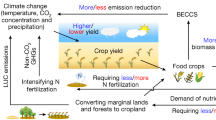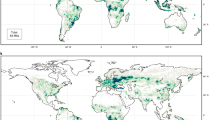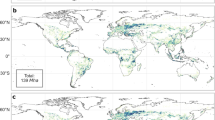Abstract
A global increase in the demand for crop-based biofuels may be met by cropland expansion, and could require the sacrifice of natural vegetation. Such land transformation alters the carbon and nitrogen cycles of the original system, and causes significant greenhouse-gas emissions, which should be considered when assessing the global warming performance of crop-based biofuels. As an indicator of this performance we propose the use of greenhouse-gas payback time (GPBT), that is, the number of years it takes before the greenhouse-gas savings due to displacing fossil fuels with biofuels equal the initial losses of carbon and nitrogen stocks from the original ecosystem. Spatially explicit global GPBTs were derived for biofuel production systems using five different feedstocks (corn, rapeseed, soybean, sugarcane and winter wheat), cultivated under no-input and high-input farm management. Overall, GPBTs were found to range between 1 and 162 years (95% range, median: 19 years) with the longest GPBTs occurring in the tropics. Replacing no-input with high-input farming typically shortened the GPBTs by 45 to 79%. Location of crop cultivation was identified as the primary factor driving variation in GPBTs. This study underscores the importance of using spatially explicit impact assessments to guide biofuel policy.
This is a preview of subscription content, access via your institution
Access options
Subscribe to this journal
Receive 12 print issues and online access
$209.00 per year
only $17.42 per issue
Buy this article
- Purchase on Springer Link
- Instant access to full article PDF
Prices may be subject to local taxes which are calculated during checkout



Similar content being viewed by others
References
Sorda, G., Banse, M. & Kemfert, C. An overview of biofuel policies across the world. Energy Policy 38, 6977–6988 (2010).
Faaij, A. P. C. Bio-energy in Europe: Changing technology choices. Energy Policy 34, 322–342 (2006).
Naik, S. N., Goud, V. V., Rout, P. K. & Dalai, A. K. Production of first and second generation biofuels: A comprehensive review. Renew. Sust. Energ. Rev. 14, 578–597 (2010).
Singh, A., Nigam, P. S. & Murphy, J. D. Renewable fuels from algae: An answer to debatable land based fuels. Bioresour. Technol. 102, 10–16 (2011).
Johnson, J. A., Runge, C. F., Senauer, B., Foley, J. & Polasky, S. Global agriculture and carbon trade-offs. Proc. Natl Acad. Sci. USA 111, 12342–12347 (2014).
Popp, A. et al. Land-use protection for climate change mitigation. Nature Clim. Change 4, 1095–1098 (2014).
Guo, L. B. & Gifford, R. M. Soil carbon stocks and land use change: A meta analysis. Glob. Change Biol. 8, 345–360 (2002).
Don, A., Schumacher, J. & Freibauer, A. Impact of tropical land-use change on soil organic carbon stocks—a meta-analysis. Glob. Change Biol. 17, 1658–1670 (2011).
Olson, K. R., Gennadiyev, A. N., Zhidkin, A. P. & Markelov, M. V. Impacts of land-use change, slope, and erosion on soil organic carbon retention and storage. Soil Sci. 177, 269–278 (2012).
Fargione, J., Hill, J., Tilman, D., Polasky, S. & Hawthorne, P. Land clearing and the biofuel carbon debt. Science 319, 1235–1238 (2008).
Searchinger, T. et al. Use of U.S. croplands for biofuels increases greenhouse gases through emissions from land-use change. Science 319, 1238–1240 (2008).
Lamers, P. & Junginger, M. The ‘debt’ is in the detail: A synthesis of recent temporal forest carbon analyses on woody biomass for energy. Biofuels Bioprod. Biorefin. 7, 373–385 (2013).
Gibbs, H. K. et al. Carbon payback times for crop-based biofuel expansion in the tropics: The effects of changing yield and technology. Environ. Res. Lett. 3, 1–10 (2008).
Havlík, P. et al. Global land-use implications of first and second generation biofuel targets. Energy Policy 39, 5690–5702 (2011).
Kim, H., Kim, S. & Dale, B. E. Biofuels, land use change, and greenhouse gas emissions: Some unexplored variables. Environ. Sci. Technol. 43, 961–967 (2009).
Yang, Y. & Sugh, S. Marginal yield, technological advances, and emissions timing in corn ethanol’s carbon payback time. Int. J. Life Cycle Assess. 20, 226–232 (2015).
Lamers, P., Junginger, M., Dymond, C. C. & Faaij, A. Damaged forests provide an opportunity to mitigate climate change. Glob. Change Biol. 6, 44–60 (2013).
Danielsen, F. et al. Biofuel plantation on forested lands: Double jeopardy for biodiversity and climate. Conserv. Biol. 23, 348–358 (2008).
Adler, P. R., Grosso, S. J. D. & Parton, W. J. Life-cycle assessment of net greenhouse-gas flux for bioenergy cropping systems. Ecol. Appl. 17, 675–691 (2007).
Hoefnagels, R., Smeets, E. & Faaij, A. Greenhouse gas footprints of different biofuel production systems. Renew. Sust. Energ. Rev. 14, 1661–1694 (2010).
Kim, S. & Dale, B. E. Life cycle assessment of fuel ethanol derived from corn grain via dry milling. Bioresour. Technol. 99, 5250–5260 (2008).
Kim, S. & Dale, B. E. Regional variations in greenhouse gas emissions of biobased products in the United States—corn-based ethanol and soybean oil. Int. J. Life Cycle Assess. 14, 540–546 (2009).
Wang, M., Huo, H. & Arora, S. Methods of dealing with co-products of biofuels in life-cycle analysis and consequent results within the U.S. context. Energy Policy 39, 5726–5736 (2011).
Flynn, H. C. et al. Quantifying global greenhouse gas emissions from land-use change for crop production. Glob. Change Biol. 18, 1622–1635 (2012).
Tilman, D., Hill, J. & Lehman, C. Carbon-negative biofuels from low-input high-diversity grassland biomass. Science 314, 1598–1600 (2006).
Conant, R. T., Paustian, K. & Elliott, E. T. Grassland management and conversion into grassland: Effects on soil carbon. Ecol. Appl. 11, 343–355 (2001).
Zan, C. S., Fyles, J. W., Girouard, P. & Samson, R. A. Carbon sequestration in perennial bioenergy, annual corn and uncultivated systems in southern Quebec. Agric. Ecosyst. Environ. 86, 135–144 (2001).
Lasco, R. D. et al. in 2006 IPCC Guidelines for National Greenhouse Gas Inventories Vol. 4 (eds Eggleston, H. S. et al.) Ch. 5, 25–41 (IPCC, IGES, 2006).
Donato, D. C. et al. Mangroves among the most carbon-rich forests in the tropics. Nature Geosci. 4, 293–297 (2011).
Jauhiainen, J., Takahashi, H., Heikkinen, J. E. P., Martikainen, P. J. & Vasander, H. Carbon fluxes from a tropical peat swamp forest floor. Glob. Change Biol. 11, 1788–1797 (2005).
Germer, J. & Sauerborn, J. Estimation of the impact of oil palm plantation establishment on greenhouse gas balance. Environ. Dev. Sustain 10, 697–716 (2008).
Murdiyarso, D., Hergoualc’h, K. & Verchot, L. V. Opportunities for reducing greenhouse gas emissions in tropical peatlands. Proc. Natl Acad. Sci. USA 107, 19655–19660 (2010).
Ruesch, A. & Gibbs, H. K. New IPCC Tier-1 Global Biomass Carbon Map For the Year 2000 (CDIAC, Oak Ridge National Laboratory, 2008); http://cdiac.ornl.gov/epubs/ndp/global˙carbon/carbon˙documentation.html
Keith, H., Mackey, B. G. & Lindenmayer, D. B. Re-evaluation of forest biomass carbon stocks and lessons from the world’s most carbon-dense forests. Proc. Natl Acad. Sci. USA 106, 11635–11640 (2009).
Weidema, B. P. et al. Data Quality Guideline for the Ecoinvent Database Version 3 (The Ecoinvent Centre, 2013).
Jaggard, K. W., Qi, A. & Ober, E. S. Possible changes to arable crop yields by 2050. Phil. Trans. R. Soc. B 365, 2835–2851 (2010).
Ewert, F., Rounsevell, M. D. A., Reginster, I., Metzger, M. J. & Leemans, R. Future scenarios of European agricultural land use: Estimating changes in crop productivity. Agric. Ecosyst. Environ. 107, 101–116 (2005).
Rosenzweig, C. et al. Assessing agricultural risks of climate change in the 21st century in a global gridded crop model intercomparison. Proc. Natl Acad. Sci. USA 111, 3268–3273 (2014).
Friend, A. D. et al. Carbon residence time dominates uncertainty in terrestrial vegetation responses to future climate and atmospheric CO2 . Proc. Natl Acad. Sci. USA 111, 3280–3285 (2014).
Van Groenigen, K. J., Qi, X., Osenberg, C. W., Luo, Y. & Hungate, B. A. Faster decomposition under increased atmospheric CO2 limits soil carbon storage. Science 344, 508–509 (2014).
Kim, S. & Dale, B. E. Indirect land use change for biofuels: Testing predictions and improving analytical methodologies. Biomass Bioenerg. 35, 3235–3240 (2011).
Zilberman, D., Hochman, G., Rajagopal, D., Sexton, S. & Timilsina, G. The impact of biofuels on commodity food prices: Assessment of findings. Am. J. Agric. Econ. 95, 275–281 (2013).
Kim, S. & Dale, B. E. Life cycle assessment of various cropping systems utilized for producing biofuels: Bioethanol and biodiesel. Biomass Bioenerg. 29, 426–439 (2005).
Börjesson, P. & Tufvesson, L. M. Agricultural crop-based biofuels—resource efficiency and environmental performance including direct land use changes. J. Clean. Prod. 19, 108–120 (2011).
Van Der Velde, M., Bouraoui, F. & Aloe, A. Pan-European regional-scale modelling of water and N efficiencies of rapeseed cultivation for biodiesel production. Glob. Change Biol. 15, 24–37 (2009).
Sierra, C. A. et al. Total carbon stocks in a tropical forest landscape of the Porce region, Colombia. Forest Ecol. Manage. 243, 299–309 (2007).
Grace, J., San José, J., Meir, P., Miranda, H. S. & Montes, R. A. Productivity and carbon fluxes of tropical savannas. J. Biogeogr. 33, 387–400 (2006).
Izaurralde, R. C., Williams, J. R., McGill, W. B., Rosenberg, N. J. & Quiroga Jakas, M. C. Simulating soil C dynamics with EPIC: Model description and testing against long-term data. Ecol. Modelling 192, 362–384 (2006).
Cherubini, F., Peters, G. P., Berntsen, T., Strømman, A. H. & Hertwich, E. CO2 emissions from biomass combustion for bioenergy: Atmospheric decay and contribution to global warming. Glob. Change Biol. 3, 413–426 (2011).
Shcherbak, I., Millar, N. & Robertson, G. P. Global metaanalysis of the nonlinear response of soil nitrous oxide (N2O) emissions to fertilizer nitrogen. Proc. Natl Acad. Sci. USA 111, 9199–9204 (2014).
De Klein, C. et al. in 2006 IPCC Guidelines for National Greenhouse Gas Inventories Vol. 4 (eds Eggleston, H. S. et al.) Ch. 11, 19–24 (IPCC, IGES, 2006).
IPCC Climate Change 2013: The Physical Science Basis (eds Stocker, T. F. et al.) (Cambridge Univ. Press, 2013).
Acknowledgements
The research was partly financially supported by three projects of the European Commission under the 7th framework program for the environment, ENV.2012.6.3-3: DESIRE—DEvelopment of a System of Indicators for a Resource efficient Europe, grant agreement 308552; ENV.2008.3.3.2.1: PROSUITE—Sustainability Assessment of Technologies, grant agreement 227078; and ENV. 2009.3.3.2.1: LC-IMPACT—Improved Life Cycle Impact Assessment methods (LCIA) for better sustainability assessment of technologies, grant agreement 243827. M.A.J.H. was further financially supported by the Dutch National Institute for Public Health and the Environment RIVM-project S/607020, Measurably Sustainable within the spearhead Healthy and Sustainable Living Environment, commissioned by the Director-General of RIVM and run under the auspices of RIVM’s Science Advisory Board.
Author information
Authors and Affiliations
Contributions
P.M.F.E., R.v.Z., M.v.d.V., M.O. and M.A.J.H. developed the methodological framework; E.S. performed the EPIC model simulations; M.v.d.V., J.B. and R.S. performed the post-processing of the simulation results; P.M.F.E. performed the GPBT calculations and statistical analyses; and all contributed to the writing of the paper.
Corresponding author
Ethics declarations
Competing interests
The authors declare no competing financial interests.
Supplementary information
Rights and permissions
About this article
Cite this article
Elshout, P., van Zelm, R., Balkovic, J. et al. Greenhouse-gas payback times for crop-based biofuels. Nature Clim Change 5, 604–610 (2015). https://doi.org/10.1038/nclimate2642
Received:
Accepted:
Published:
Issue Date:
DOI: https://doi.org/10.1038/nclimate2642
This article is cited by
-
The potential land requirements and related land use change emissions of solar energy
Scientific Reports (2021)
-
Towards net zero CO2 emissions without relying on massive carbon dioxide removal
Sustainability Science (2019)
-
Greenhouse gas emission curves for advanced biofuel supply chains
Nature Climate Change (2017)
-
Assessing the food security outcomes of industrial crop expansion in smallholder settings: insights from cotton production in Northern Ghana and sugarcane production in Central Ethiopia
Sustainability Science (2017)
-
Spatial and technological variability in the carbon footprint of durum wheat production in Iran
The International Journal of Life Cycle Assessment (2017)



